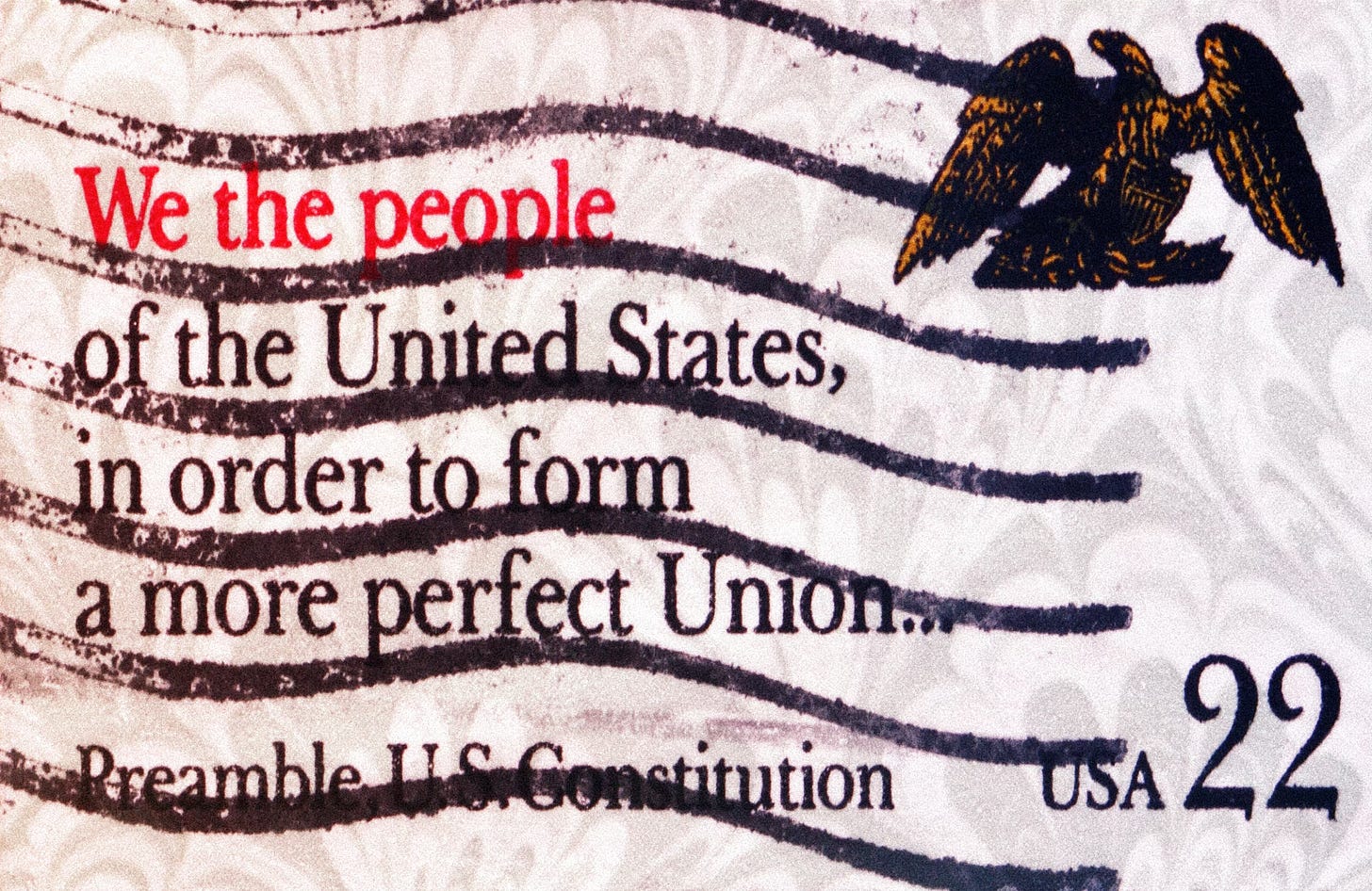America Needs a Bold Constitutional Reconstruction Agenda to Tame Presidential Powers
Fundamental flaws in our parliamentary rules, courts, and electoral system made our country vulnerable to an authoritarian takeover
Donald Trump’s second term is not merely a crisis of leadership, policy, or ideology—it is a structural crisis, one that exposes deep flaws in the constitutional order itself. For years, these flaws have been accumulating pressure, patched over with short-term fixes and the inertia of tradition. Now the contradictions have grown too large, and the system has reached a breaking point.
At its core, the American liberal order has relied on oaths: to uphold the Constitution, to preserve the rule of law, and to honor democratic norms. These oaths are not just trivial ceremonies. The substantive commitment they signify is carried out in practice, in ways big and small that build and maintain the whole edifice. Imperfectly and with exceptions, those who have taken that oath have mostly meant it and attempted to follow it. But what happens when the system’s most powerful office is occupied by someone for whom the oath is meaningless? A presidency built on hierarchical command and consolidated authority over the executive branch, once intended to be checked by a web of institutional balances, has instead become a tool for personalist rule and authoritarian ambition.
If American liberal democracy is to survive, it must do more than weather Trump’s second term and the constitutional omni-crisis it has provoked. It must confront the structural defects that made this collapse possible, and correct them with the same boldness that characterized past eras of constitutional reconstruction, including the original drafting and ratification of our supreme law of the land. The Constitution must be saved from itself, as it was intended to be.
Turnkey Tyranny
The U.S. presidency is a glaring outlier in global democracy. Its immense concentration of executive power creates a brittle system where democratic legitimacy hinges on the character of one individual. When that individual rejects the very premise of accountability and oaths to the Constitution, the system offers few effective remedies.
Impeachment, designed as the ultimate check on presidential misconduct, has failed in practice. Partisan loyalties overpower constitutional obligations, rendering the process politically toxic and practically impossible. A more glaring demonstration could not be imagined than Trump’s acquittal in the second impeachment trial, with 57 senators voting to convict but still short of the two-thirds needed. The ban on insurrectionists holding public office, carefully and deliberately crafted in the 14th Amendment, has likewise proven unworkable when courts and political institutions lack the will to enforce it.
The issue is not just Trump, but the structural incentives that allow and even encourage figures like him to rise. A presidency that blends the roles of head of state and head of government grants an aura of legitimacy and dominance that parliamentary or collegial executive systems diffuse among multiple offices. This makes the executive branch inherently prone to demagoguery, populism, and personalist rule.
The concern did not go unnoticed at the constitutional convention. Edmund Randolph objected that the proposed presidency would be “the foetus of monarchy.” Charles Pinckney feared an overpowered chief executive would become “a monarchy, of the worst kind, to wit an elective one.” Benjamin Franklin urged the assembled delegates to carefully consider the issue, “a point of great importance.”
But these concerns did not carry the day, perhaps colored by how the delegates debated under the gaze of George Washington, presiding over the convention, understood by all to be first in line to head the new government. It might have been the most consequential decision the convention made, and the test of time has proven it to be a grave miscalculation.
To address this flaw, reforms must decentralize power within the executive branch and return the partisan policy-making arena to Congress where it belongs. A Westminster-style parliamentary system has its own drawbacks and would be too foreign to the American tradition, but less radical reforms could still check the chief executive while preserving our historical attachment to the job title.
To ensure that our head of state is not practically exempt from but subject to the law, powers must be arranged so that the law can actually be enforced on our highest office. The lawless notion that presidents enjoy near-absolute immunity from criminal prosecution must be repudiated, eventually by constitutional amendment if need be. Impeachment should be made a more effective threat, perhaps by lowering the two-thirds threshold required for conviction in the Senate, though not necessarily to a mere simple majority. Officers impeached by the House could also be suspended from office pending the outcome of the trial, as we have recently seen used to good effect in South Korea. And within the executive branch, key officials should have not just the theoretical duty but the practical ability to refuse unlawful presidential orders—to at least tap the brakes until other institutions such as the courts can weigh in.
Correcting the Court
At the core of our Constitution’s crisis of structural misalignment is the catastrophic decline of the Supreme Court. With lifetime tenure and appointments tied to the happenstance timing of deaths and the partisan gaming of strategically timed retirements, the court has become unbound from its intended democratic accountability. The judiciary serves as an independent check on the other two branches, and the American model of strong judicial review has accomplished great things. But the court is still ultimately supposed to be a lagging indicator of election results over time, for president and Senate.
This careful balancing act of judicial independence and democratic accountability has been failing to work as intended. And there are good reasons to want reform even if you prefer a more conservative and originalist court, as the status quo both erodes the quality of the court’s output and fuels a crisis of legitimacy which is careening toward a breaking point. The fix needed is a simple one with broad support: ditch life tenure for a lengthy fixed term, with seats coming up on a predictable, known schedule.
If appointments to the nine-member court were distributed evenly across presidential terms—say, two per term, with each justice serving 18 years—the court at the start of Trump’s second term would have a 6-3 Democratic-appointed majority, reflecting that Democrats have won three of the five presidential elections from 2004 to 2020.
Of these, one from each party’s president would have been appointed while the other party held the Senate, assuming one justice appointed before and after the midterms. Once common, a justice has not been nominated and confirmed under such divided control in more than 30 years. With seats coming open on a regular schedule, there would be less incentive for partisan obstruction and deadlock over any one nominee. The incentives change when both parties know the shoe will be on the other foot soon enough.
By the end of his second term, Trump would have replaced one Bush and one Obama appointee, resulting in a 5-4 balance, in line with the fact that Democrats have won three of the preceding five elections, from 2008 to 2024. Under the staggered appointment schedule, no president would appoint more than four justices (except in the unusual case of a two-term president filling a premature vacancy, who would only hold the seat for the unexpired remainder of that justice’s term).
Instead, it is quite likely that an outright majority of the court will soon be Trump appointees for a very long time, if any two of Alito, Thomas, or Roberts step aside or pass away in the next four years. Lifetime tenure also produces justices who cling to their seats far into the infirmities of old age: Thurgood Marshall, Ruth Bader Ginsburg, William Rehnquist, Antonin Scalia. The result is a deeply morbid and unhealthy death watch, as the balance of the court hinges on the health of fading octogenarians. A fixed term of 18 years would, instead, enable appointment of justices in their 40s and 50s who would serve until their late 60s or early 70s. It would head off the threat of court packing by permanently fixing the number of justices at nine. It would avoid the unseemly open partisanship of justices timing their retirements according to which party controls the White House and Senate, fueling the perception that they are little more than politicians in robes.
And it would cut short the trend of appointing younger and less qualified justices just to hold the seat for longer, instead making the job more like what it should be: the culmination of an accomplished career as a jurist and legal scholar. As it stands, strategic retirements and random vacancies have allowed the court to tilt sharply to the right, effectively locking in that supermajority regardless of long-term election results. Even for those who tend to agree more with the current court’s rulings, the resulting crisis of legitimacy threatens the viability of judicial review itself. And random chance could just easily tilt the other way some day, with Democrats coming to enjoy a self-entrenching majority. Court reform in this vein need not be a partisan issue, and has attracted support from experts across the ideological spectrum. It is also, unlike talk of court-packing, popular with the voters.
This disconnect between the court’s composition and its intended indirect accountability to election results is not sustainable. The court’s legitimacy depends on its ability to serve as a stabilizing force, not an arbitrary advantage for one party over the other. Implementing 18-year term limits for justices, with regularly staggered appointments, would restore fairness while preserving judicial independence. It is necessary to align the court more closely with long-term will of the people in order to maintain its proper role as a check against short-term political pressures.
Our Unrepresentative Democracy
The structural problems extend beyond the presidency and the courts. Congress, the supposed epicenter of representative democracy, has abdicated its charge to check the other two branches. This has its roots in the systemic incentives of our electoral system.
Single-member districts and first-past-the-post voting create a system where the two major parties dominate, leaving no room for more fluid competition or coalition-building. The party primary system, run by the government for the benefit of ostensibly private political parties, ensures that most races are decided not by general election voters but by the small fraction of partisans who turn out in primaries.
Though we take it for granted, government-run primary elections for party members to pick their nominees are an American aberration, almost unheard of in other democracies. Intended as a democratizing reform during the Progressive era, primary elections were supposed to break open the corrupt smoke-filled rooms of party insiders. But they have backfired, severely undermining democracy by supercharging the power of an unrepresentative subset of the electorate.
At the same time, government-administered primaries produce America’s uniquely absolute two-party-only system, by lowering the cost of intra-party competition relative to inter-party competition. In other words, it becomes irrational for serious politicians to launch their own competitor party rather than compete in the primaries. The end result is that the number of seriously contested primaries far outstrips the number of seriously contested general elections. This is why other nations which also use the first-past-the-post electoral system, with its Duverger’s Law tendency towards two dominant parties, still see smaller parties win some legislative seats, but we do not.
This system must be overhauled. Proportional representation, ranked-choice voting, increasing the size of the House, fusion voting, and nonpartisan primaries all offer ways to open the political arena to new voices, put some play in the joints of the two-party system, and restore genuine representation of the broader electorate. Any of these ideas can be debated, but they all share the same broad goal, and experimentation at the state and local level is worthwhile. Here is where our federalist “laboratories of democracy” can shine, providing important lessons and potential models to follow nationwide, while misfired attempts can be discarded.
Electoral reform is not a fringe issue; it is the foundation for rebuilding democratic legitimacy and responsiveness. Some reforms can be achieved by statute without the need for constitutional amendment. Others can be enacted by simply giving states freedom to experiment, serving as laboratories of democracy in the search for better systems of representation.
Under the status quo, tens of millions of voters are left without a seat at the table, without a representative they voted for: rural Democrats, urban Republicans, independents locked out of the primaries. These voters in large part represent the missing middle of American politics, a greater diversity of opinion and tendency towards moderation than is reflected in our homogenized, polarized election results. John Adams observed that the purpose of a representative legislature is to be “in miniature, an exact portrait of the people at large. It should think, feel, reason, and act like them.” Few could look at Congress today and say it fits that description.
A New Constitutional Reconstruction
As the need for constitutional reform grows more urgent, so does the temptation to use the moment as a vehicle for enshrining partisan policy preferences. Proposals to radically reshape policy by constitutional entrenchment abound on both the left and right, from universal healthcare to flag-burning amendments. But while these ideas may energize activists, most are unlikely to ever gain the bipartisan supermajority required for constitutional amendments. Worse, they risk turning structural reform into just another front in the culture wars, undermining the broad legitimacy any new constitutional settlement must command.
If amendment efforts devolve into partisan wishlists, they will fail. Constitutional reform requires broad legitimacy, not narrow victories. The challenge is to distinguish between the timeless principles that a constitution must enshrine and the temporary preferences that belong in ordinary politics and legislation.
The flaws in the American constitutional order are not new, but Trump’s second term is forcing a reckoning with them. Just as the Civil War and Reconstruction Amendments addressed the systemic failures of the 1787 Constitution, so must this generation confront the contradictions exposed by modern crises. Doing so would not be a rejection of the Constitution’s principles but an embrace of them, including the original intent of Article V’s amendment procedures. The Framers expected us to amend the Constitution much more often than we have. They weren’t unaware of how difficult the supermajority requirements would be—but they believed we would meet that threshold through our ability to form sufficient consensus on needed changes.
A program of serious constitutional reform does not mean discarding the Madisonian principles of checks and balances, federalism, and limited government. Rather, it means applying those principles to contemporary challenges with the same boldness the Framers themselves showed, and was shown again by the authors of the Reconstruction Amendments.
It means reforming the presidency to prevent authoritarian drift and democratic backsliding, modernizing the Supreme Court to reflect a better balance of independence and accountability, and rebuilding Congress to be more truly representative of the American people. It means embracing a radical vision of reform rooted in liberal principles—freedom, equality, and the rule of law—while acknowledging that some outdated structures no longer serve those ends.
Saving the Constitution from itself is not a rejection of its values; it is an affirmation of them. It is an acknowledgment that, as Lincoln said, “the dogmas of the quiet past are inadequate to the stormy present.” The work of building a more perfect union did not end in 1787, or in 1868. It must continue today, if we are to “secure the Blessings of Liberty to ourselves and our Posterity” with a Constitution fit for future generations.
One last thing…
The above essay is about the situation in the U.S., but we also wanted to tell you about an informative venue that focuses on global affairs: World Politics Review. WPR covers key countries and regions that mainstream outlets often ignore. As regular readers of The UnPopulist know, that global focus is one we deeply care about as well. So please give World Politics Review a look—and consider subscribing. We’ve found it a reliable and insightful publication.
An earlier version of this essay first appeared in Liberal Currents. It is republished here with permission.
Follow us on Bluesky, Threads, YouTube, TikTok, Facebook, Instagram, and X.
We welcome your reactions and replies. Please adhere to our comments policy.










Bravo! The very fact that Donald Trump could get elected as leader of a main party, let alone as president, made it perfectly clear that American democracy was broken. The Democrats nominating someone with dementia showed the rot is affecting both parties. I hope this article sparks a serious reform movement to fix the issue. It is long overdue.
There’s no one alive today whom I trust to fiddle with the constitution.